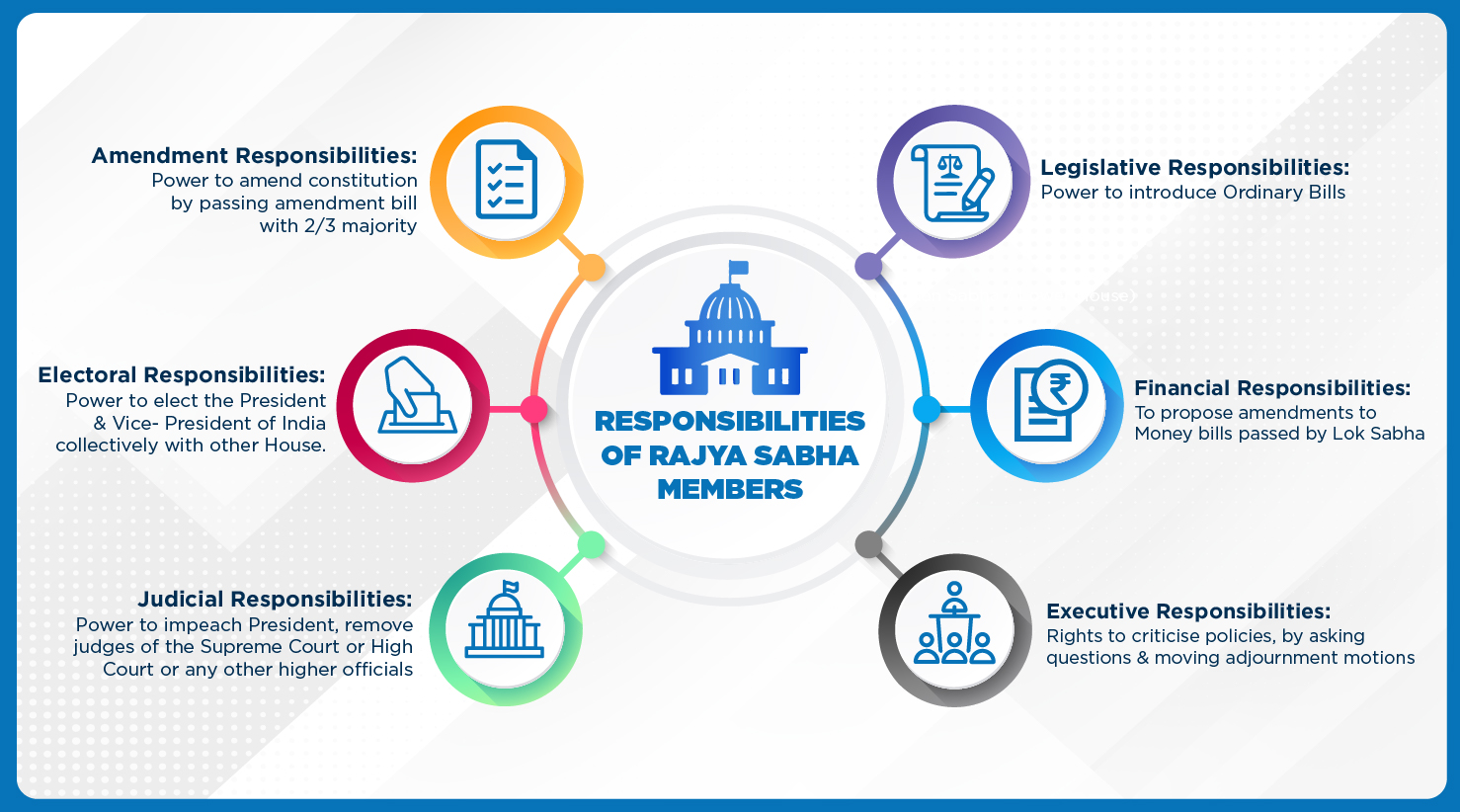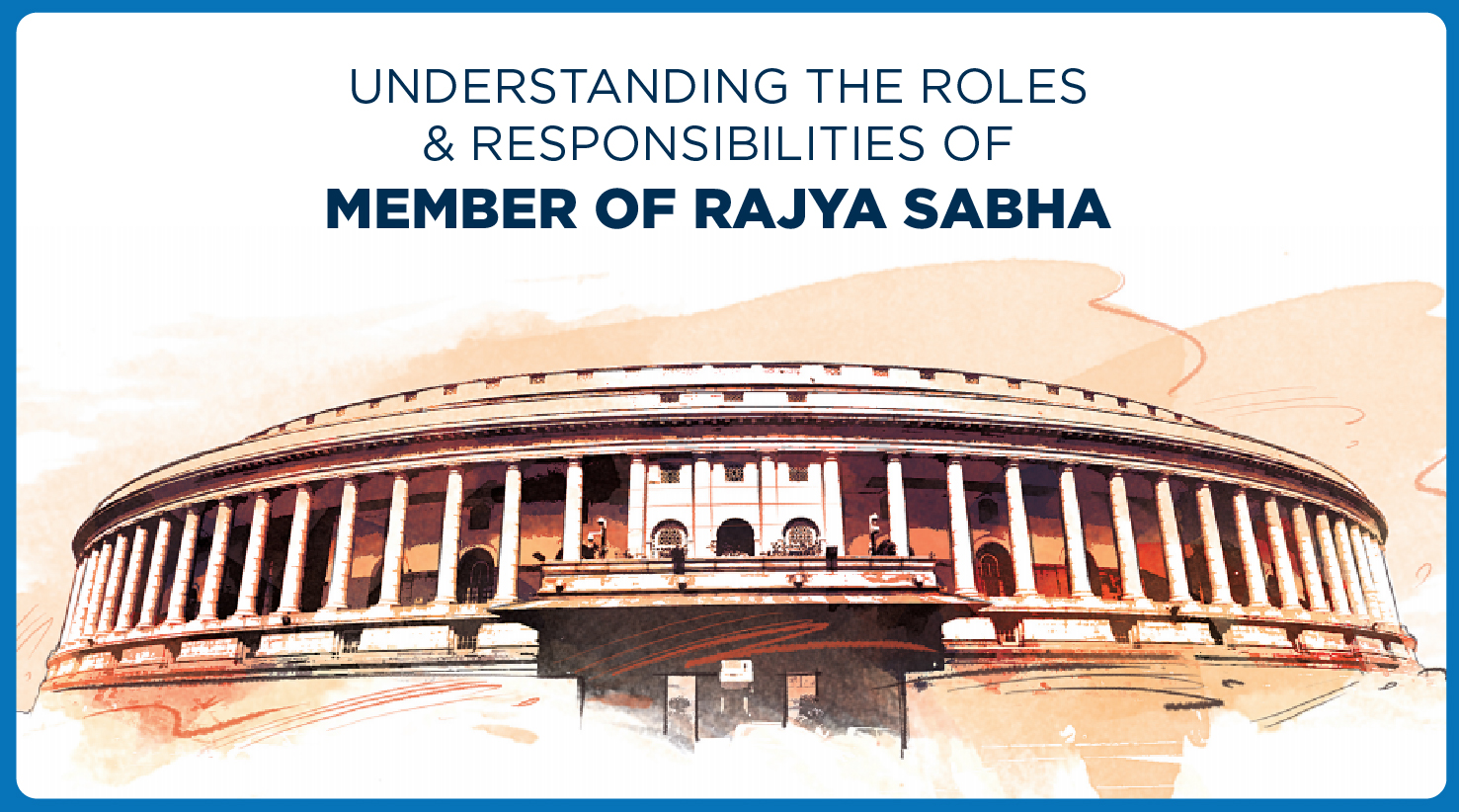The ‘Council of States’, ‘House of Elders’, ‘The Second Chamber’ are a few of the several names of Rajya Sabha, which is the upper house of India’s bicameral constitution. The origin of Rajya Sabha can be traced to the Montague-Chelmsford Report, of 1918 which became a theoretical basis of the Government of India Act, 1919, which led to the creation of a ‘Council of State’ as a second chamber of the then legislature in 1921. The nomenclature of Rajya Sabha was later announced by the chair in the House on 23rd August, 1954.
Owing to the diverse composition of the house from various fields, Rajya Sabha, over the time earned several monikers and reputations which are often associated with the In-House celebrity members who are often devoid of powers. But is this truly the case or do the members of Rajya Sabha have crucial responsibilities which often remain in the hindsight. Let’s discover.
The Structure & Composition:

The Rajya Sabha was structured by the framers of the Indian constitution to represent the interests of the states and union territories. However, the states do not have equal representation in the Rajya Sabha as allotment is done on the basis of the size of each state’s population.
As per Article 80 of the Constitution, the maximum strength of Rajya Sabha has to be not more than 250, out of which 12 members are nominated by the President and 238 are representatives of the States and Union Territories. The members nominated by the President are those people who have special knowledge or practical experience in fields related to literature, science, art and social service.
Unlike Lok Sabha, the Rajya Sabha plays a role of a permanent house which is not subjected to dissolution, where one-third of its members retire every two years and each member has a tenure of six years. The members of the Rajya Sabha are elected the members of their state legislative assembly (MLA) by a method of proportional representation—single transferable vote system, as per the allocation laid by the Constitution. As per Article 84 of the Constitution, qualifications of a Rajya Sabha member are as follows:
- Must be a citizen of India.
- Must be at least 30 years old.
- Must be elected by the Legislative Assembly of States and Union territories by means of single transferable vote through proportional representation.
- Must not be a proclaimed criminal or of unsound mind.
- Must not be a subject of insolvent, i.e. he/she should not be in debt that he/she is not capable of repaying in a current manner.
- Must not hold any other office of profit under the Government of India.
- Must possess such other qualifications as may be prescribed in that behalf by or under any law made by Parliament.
The members of Rajya Sabha are presided over by the Vice-President of India, who is ex-officio Chairman of Rajya Sabha with a responsibility to conduct the proceedings of the house. Rajya Sabha also elects a Deputy Chairman from amongst its members.
The Responsibilities Of Rajya Sabha Members:

As the Second Chamber, Rajya Sabha plays a crucial role of revisionary house while reconsidering bills passed by the Lok Sabha and offers a degree of continuity in the underlying policies of laws passed by parliament. Along with this, Rajya Sabha also institutionalizes the federal principles of power-sharing between the Centre and states.
- Legislative Responsibilities:
In the sphere of legislation and law-making the Rajya Sabha has equal footing with the Lok Sabha, except in the area of fund supply, where the latter has overriding powers. The Rajya Sabha has the power to introduce an ordinary bill which cannot become a law unless passed by it. However in case of a deadlock situation between the two Houses of Parliament over an ordinary bill which remains unresolved for six months, the President summons a joint sitting which is presided over by the Speaker of the Lok Sabha. Once the bill is passed in the joint sitting, it is sent to the President for his signatures. But the bill is deemed to have been killed if the deadlock is not resolved.
- Financial Responsibilities:
When it comes to the financial role, the Rajya Sabha is a weak House, mostly devoid of powers. A money bill cannot be initiated in the Rajya Sabha and can only be done by the Lok Sabha. Lok Sabha after introducing the money bill passes to Rajya Sabha for its consideration. However, if within a period of 14 days, the Rajya Sabha fails to pass the bill, the bill is taken to have been passed by the Parliament irrespective of Rajya Sabha’s judgement. If the Rajya Sabha proposes some amendments and the bill is returned to the Lok Sabha, it depends upon the Lok Sabha to accept or reject the proposed amendments.
- Executive Responsibilities:
Unlike Lok Sabha which alone can cause the fall of the Council of Ministers by passing a vote of no-confidence, Rajya Sabha cannot remove the members of the Ministry. But Rajya Sabha can exercise some control over the ministers by criticising their policies, by asking questions and moving adjournment motions.
- Amendment Responsibilities:
Rajya Sabha Members have the power to amend the constitution by passing an amendment bill with 2/3 majority in each House.
- Electoral Responsibilities:
The Rajya Sabha Members along with Lok Sabha members and the State Legislative Assemblies elect the President of India. The members of the Rajya Sabha also elect the Vice- President of India.
- Judicial Responsibilities:
The Rajya Sabha Members also have judicial power along with the Lok Sabha, wherein they can impeach the President on charges of violation of the Constitution, remove judges of the Supreme Court or of any High Court or pass a resolution for the removal of officers like the Attorney General of India and Chief Election Commissioner.
- Special Responsibilities:
- To declare a subject of State List as a subject of National Importance, by passing a resolution by 2/3rd majority of its members. Such resolutions can be repeatedly passed by Rajya Sabha, empowering the Union Parliament to legislate on such a state subject for a period of one year.
- To create or abolish one or more All India Service by passing a resolution supported by 2/3rd majority on the plea of national interest.
The Roles Of Rajya Sabha Members:

Safety Valve of India’s Federal Policy: Bicameralism is necessary for a federal constitution to give representation to the units of the federation, Rajya Sabha thus becomes a safety valve of India’s Federal Policy, by representing a crucial component of the constitutional checks and balances scheme. Checks and balances usually operate between the executive, legislature and judiciary; the Council of States acts as a safety valve within the legislature itself, easing federal tensions.
Review and Evaluation Role: The main objective behind the creation of Rajya Sabha was to build a revisionary house to keep a check on the hasty legislation that could be passed by the lower house under populist pressures, as Rajya Sabha can delay the passing of bills.
As Deliberative Body: Apart from being a legislative body, Parliament is also a deliberative body which enables the members to debate over issues related to public importance. Thus, the role of the Upper House is to be a deliberative body besides balancing the unpredictable nature of the Lok Sabha.
Representing the Vulnerable Sections: Under represented sections of society on grounds of religions, gender, ethnicity and linguistic minority are not adequately represented in the Lok Sabha. Therefore an indirect form of election to the Rajya Sabha, would give them a chance to get involved in the nation’s law-making process.
The Challenges:
The Indian Constitution ensures parity of powers between the Lok Sabha and the Rajya Sabha in law, making an exception in some cases. Despite this Rajya Sabha faces a couple of challenges due to restricted powers. For example:
- Unequal representation of state relative to the populations.
- In some cases, ordinary bills are being passed in the form of a Money Bill to avoid the Rajya Sabha which questions the significance of the upper house of Parliament.
- The removal of the word ‘domicile’ from Section 3 of Representation of People (Amendment) Act, 2003, gave power to those people to contest the Rajya Sabha elections from that state of which they are neither a resident nor a domicile. After the amendment, the seats in the Rajya Sabha have been used by the ruling party to get their defeated candidate in Lok Sabha, elected in Rajya Sabha.
- Low participation from the Members of Rajya Sabha.
- Friction between both the Houses with regards to delays and disruptions while passing bills and motions.
The Key Takeaways:
The Rajya Sabha is a melting pot of cultural diversity, which despite the unpredictability of Indian politics, has remained a vanguard for political and social values. Even though it has been less powerful than Lok Sabha, its significance and contribution is not something which can be easily overlooked. Along with Lok sabha, it is a flag-bearer of the sovereign, secular and democratic republic, constantly steering the socio-economic transformation of India since 1952.
References:





